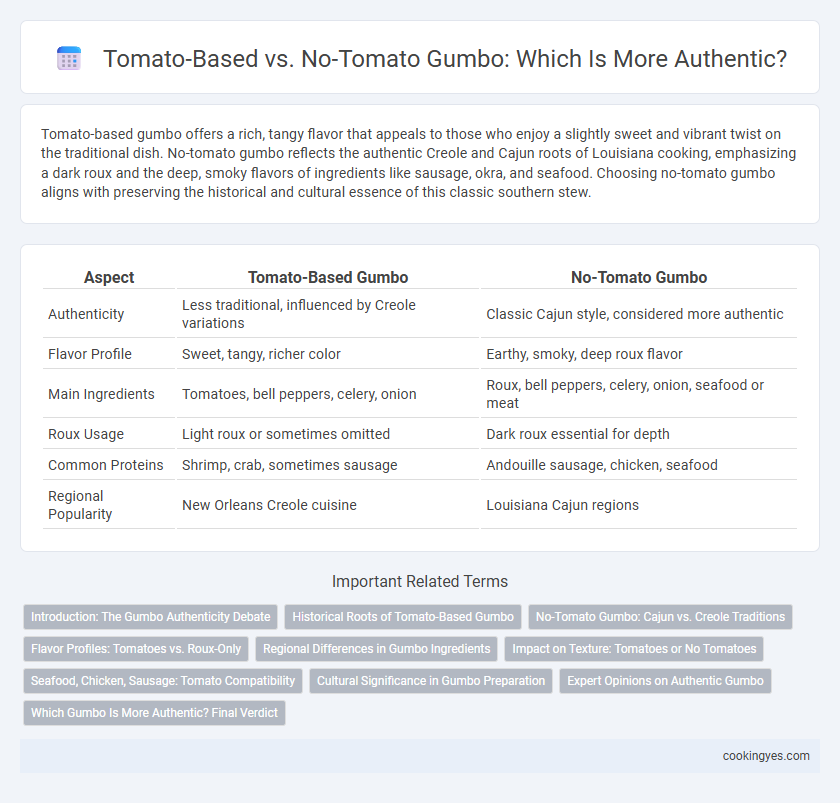Tomato-based gumbo offers a rich, tangy flavor that appeals to those who enjoy a slightly sweet and vibrant twist on the traditional dish. No-tomato gumbo reflects the authentic Creole and Cajun roots of Louisiana cooking, emphasizing a dark roux and the deep, smoky flavors of ingredients like sausage, okra, and seafood. Choosing no-tomato gumbo aligns with preserving the historical and cultural essence of this classic southern stew.
Table of Comparison
| Aspect | Tomato-Based Gumbo | No-Tomato Gumbo |
|---|---|---|
| Authenticity | Less traditional, influenced by Creole variations | Classic Cajun style, considered more authentic |
| Flavor Profile | Sweet, tangy, richer color | Earthy, smoky, deep roux flavor |
| Main Ingredients | Tomatoes, bell peppers, celery, onion | Roux, bell peppers, celery, onion, seafood or meat |
| Roux Usage | Light roux or sometimes omitted | Dark roux essential for depth |
| Common Proteins | Shrimp, crab, sometimes sausage | Andouille sausage, chicken, seafood |
| Regional Popularity | New Orleans Creole cuisine | Louisiana Cajun regions |
Introduction: The Gumbo Authenticity Debate
Tomato-based gumbo reflects regional variations, particularly in Creole cooking where tomatoes enhance the dish's rich, layered flavors. No-tomato gumbo, often associated with Cajun tradition, emphasizes a dark roux and the holy trinity of vegetables, preserving the original West African and French influences. Authenticity in gumbo hinges on these cultural distinctions, highlighting the dish's diverse heritage.
Historical Roots of Tomato-Based Gumbo
Tomato-based gumbo traces its roots to Creole cooking traditions that emerged in New Orleans during the 18th century, blending French, Spanish, and African culinary influences. Historical records indicate the use of tomatoes in gumbo recipes around the late 19th century, marking a regional variation distinct from the roux-thickened, okra or file gumbo favored by Cajun communities in southwest Louisiana. Tomato-based gumbo authentically reflects the multicultural heritage and coastal ingredients typical of Creole cuisine, distinguishing it from no-tomato gumbo styles rooted in inland Cajun practices.
No-Tomato Gumbo: Cajun vs. Creole Traditions
No-tomato gumbo epitomizes Cajun culinary tradition, emphasizing dark roux and smoked meats without the acidity of tomatoes. Creole gumbo, often tomato-based, reflects French and Spanish influences with a lighter, more tomato-forward broth. Authentic Cajun gumbo relies on the rich, earthy flavors of the roux and local ingredients, preserving its heritage distinct from the sweeter, tomato-infused Creole style.
Flavor Profiles: Tomatoes vs. Roux-Only
Tomato-based gumbo offers a tangy, slightly sweet flavor that enhances the dish's acidity and pairs well with seafood, creating a vibrant taste profile often favored in Creole cooking. No-tomato gumbo relies on a rich, deeply browned roux as its base, which develops nutty, caramelized notes essential to traditional Cajun gumbo's authentic, earthy flavor. The choice between tomato and roux-only gumbo highlights regional variations, with roux-only emphasizing depth and complexity while tomato-based adds brightness and a distinct savory balance.
Regional Differences in Gumbo Ingredients
Tomato-based gumbo is a hallmark of Creole cooking in New Orleans, where sweet and tangy tomatoes complement the rich seafood and sausage flavors, reflecting French and Spanish influences. No-tomato gumbo, often found in Cajun cuisine of southwestern Louisiana, emphasizes a dark roux with smoked meats and the "holy trinity" of bell peppers, onions, and celery, highlighting rural, rustic traditions. These regional ingredient variations demonstrate how gumbo's authenticity is deeply tied to local history and cultural blends within Louisiana.
Impact on Texture: Tomatoes or No Tomatoes
Tomato-based gumbo introduces a slightly tangy, acidic layer that softens the roux and thickens the broth, creating a smoother, more stew-like texture. No-tomato gumbo relies on a darker roux and the natural gelatin from meats or shellfish, resulting in a richer, silkier texture with a more pronounced depth. The presence or absence of tomatoes fundamentally alters the gumbo's mouthfeel, balancing between a heartier, creamier consistency and a lighter, zestier broth.
Seafood, Chicken, Sausage: Tomato Compatibility
Tomato-based gumbo often aligns with Creole traditions, especially when combining seafood like shrimp and crab with chicken and sausage, as the acidity of tomatoes enhances the rich, savory flavors. No-tomato gumbo, typically favored in Cajun cuisine, relies on dark roux and smoky spices to complement the seafood, chicken, and sausage without overpowering their natural taste. The choice between tomato and no-tomato gumbo impacts authenticity, with seafood-focused recipes leaning toward tomato inclusion for a balanced flavor profile, while chicken and sausage gumbo tend to preserve tradition through tomato-free preparations.
Cultural Significance in Gumbo Preparation
Tomato-based gumbo is more commonly associated with Creole cuisine, reflecting the French and Spanish influences in New Orleans, while no-tomato gumbo aligns with Cajun traditions rooted in rural Louisiana, emphasizing local ingredients like dark roux and smoked meats. The cultural significance of tomato-free gumbo lies in its preservation of ancestral cooking methods and regional identity, highlighting the diversity within Louisiana's culinary heritage. Both versions symbolize distinct cultural narratives, showcasing how regional preferences shape the authenticity and historical importance of gumbo preparation.
Expert Opinions on Authentic Gumbo
Expert chefs and culinary historians emphasize that traditional gumbo often excludes tomatoes, especially in Creole and Cajun recipes rooted in Louisiana's heritage. Authentic gumbo typically relies on a dark roux, the "holy trinity" of vegetables, and regional proteins, with tomatoes considered a modern twist rather than a classic ingredient. Renowned gumbo authorities, such as Chef Leah Chase and food historian Jessica B. Harris, highlight that tomato-based versions reflect contemporary adaptations rather than the original, historic gumbo styles.
Which Gumbo Is More Authentic? Final Verdict
Tomato-based gumbo is more common in Creole cuisine, reflecting New Orleans' French-Cajun fusion influenced by Spanish and African cultures, while no-tomato gumbo, often roux-based with okra or file powder, aligns more closely with traditional Cajun recipes from rural Louisiana. Authenticity depends largely on regional lineage, with Cajun gumbo typically avoiding tomatoes and emphasizing deep, smoky roux flavors, contrasted by Creole versions incorporating tomatoes for a brighter taste. The final verdict favors no-tomato gumbo as the more authentic traditional dish, while tomato-based gumbo represents a valid regional variation within the broader gumbo spectrum.
Tomato-based gumbo vs No-tomato gumbo for authenticity Infographic

 cookingyes.com
cookingyes.com